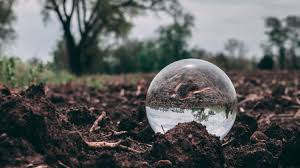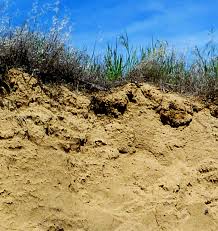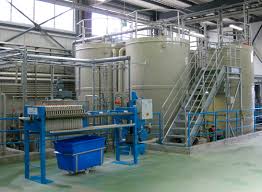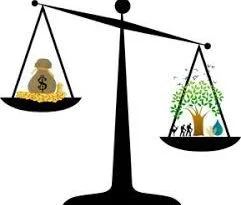The Four (4) Forms of Complex Processes of Soil Formation
You will recall that there are two types of processes of soil formation. These are the simple and complex processes of soil formation. In this article, we will consider the complex processes of soil formation.
Complex processes of soil formation are all distinguished mainly on climatic basis but they are by means mutually exclusive. It is necessary to point out that boundaries of these processes are not easy to establish hence boundaries are arbitrary.
The Four (4) Forms of Complex Processes of Soil Formation
The complex processes of soil formation include lateritisation, podsolisation, calcification, gleisation, salinisation and solodisation. As pointed out either these processes are not mutually exclusive.
1. Lateritisation Process
This is the process which forms laterites and lateritic soils. They are also known as latosols, oxisols and ferruginous tropical soils.
Lateritisation process operates mainly in the warm to hot humid regions particularly in the equatorial, tropical and monsoon climates of the world. In these hot climates, vegetation is luxuriant and this also helps lateritisation process.
Another factor is topography. This is particularly important in relation to the groundwater situation as well as to the depth of the effective soil.
Read Also : The Six (6) Physical Properties of Soil
Some characteristics of lateritisation process are:
Long and uninterrupted period of rock weathering and soil formation result in deep and intensely weathered parent material;
Leaf fall from the luxuriant forest and its rapid decay keeps the basis in rapid circulation between soil and vegetation;
Mineralization of organic matter is complete and rapid while the intense chemical weathering of rocks releases bases from the mineral fragments still remaining in the soil;
Alteration of the high-silicate clays (montmorilonite and illite) into low-silicate days such as kaolinite to a point where only a residue of kaolin, iron and aluminium sesquioxides, in various degrees of hydration possess small inclusions or impurities;
Formation of a stratified or an unstratified soil profile.
2. Podsolisation Process
Unlike lateritisation, podsolisationprocess is prevalent in the cool humid areas of Koppen’s C and D climates. The word podsolisation is derived from the Russian term “podsol” meaning “ash underneath”.
The process produces the podsols and the podsolic soils. In these soils the profiles are distinct both in appearance and in their physical and chemical properties. It is for these reasons that the typical ideal soil profile is the podsol because of the clear-cut development of the horizons and parts thereof.
It should also be noted that because of the high acid content of the soil solution with a pH level of between 3 and 4, the leaching, especially of the bases and soil colloids is much more intense than in any other soil.

Some other characteristics of podsolisation are the;
Presence of soluble bases (i.e. metallic cations) which are displaced from the soil colloidal interfaces and removed from the solum by groundwater;
Availability of aluminium and iron sesquioxides that become mobile and susbsequently transported downward in the soil thus making the A2 horizon somewhat lighter in colour than it was previously;
Tendency of inorganic clays to be peptised and making it to be susceptible to dispersion and downward movement; and
Tendency of an illuvial B horizon to develop at depth, as a result of the deposition of the susquioxides, lags, bases and humus which primarily results from reduction in soil acidity.
3. Calcification Process
This process is characteristics of low-rainfall areas, especially in the continental interiors. As such it is characteristic of the grassland regions, including the savannas, but especially the temperate grassland areas.
Other characteristics of calcification process include:
The formation of a calcic horizon usually within the B or C horizon, and a mollic horizon or a soft friable surface horizon containing a high percentage of organic colloids, well saturated with calcium ions.
The prevalence of lime in the soils thereby they are collectively called pedocals or soils of calcium;
Some downward movement of solutions and materials takes place even though leaching is not prominent;
The net loss of soil water because evapotranspiration exceeds precipitation;
The precipitation of ions in the order calcium and magnesium bicarbonates followed by calcium sulphates, and
The formation of a crust known as calcrete.
4. Gleisation Process
This process occurs in areas with impeded drainage conditions. In effect gleying can occur in any climate environment, i.e. within zonal soils. The presence of this process may be due to;
Topographic effects e.g. valley bottoms and swampy low-relief areas;
Geological influence e.g. poorly drained, clayey soils, and
Climate e.g. in the permafrost areas of the cold regions.
The soils formed under these conditions are grouped together as hydromorphic soils. The major characteristics of gleisation process are:
Mottling of soils especially where periodic drying takes place;
The formation of an impervious horizon within the soil profile causing surface-water gleying;
The formation of an impervious horizon beneath the soil profile causing groundwater gleying;
The formation of homogeneously grey or grayish-white soils, and
The production of mottles of rust-coloured ferric oxide making mottling a prominent feature of most hydromorphic soils.
In this article, you would have noticed that complex processes of soil formation relate very much to climatic conditions especially with the element of rainfall. Hence, while lateritisation is found in warm to hot humid tropical areas, podsolisation process takes place in cool humid areas of temperate regions.
In the case of calcification process, it is found in areas where rainfall is low especially in the continental interiors. Although, gleisation process could take place in any climatic environment the role of rainfall is important before we can have impeded drainage conditions.
The four important soil formation processes are considered. They are lateritisation, podsolisation, calcification and gleisation. It is also important to note that these processes have certain distinguishing characteristics. Some of the important ones include.
A long period of uninterrupted rock weathering with soil having deep weathered parent material; mineralization of organic matter and a formation of a stratified or unstratified soil profile in the case of lateralization process;
A high aid content; leaching of the bases and soil colloids more than in any other soil; availability of mobile aluminium and iron sesquioxides in the A2 horizon which are subsequently transported and a clear-cut development of the soil horizons in the case of podsolisation process;
The formation of a calcic and mollic horizons; prevalence of line in the soils bringing about pedocals; net loss of soil water; the precipitation of ions and the formation of calcrete in the case of calcification process;
The mottling of soils due to periodic drying; formation of impervious horizon beneath the soil profile; formation of uniform grayish-white soils and production of rust- coloured ferric oxide mottles denoting hydromorphic conditions in the case of gleisationprocess.



